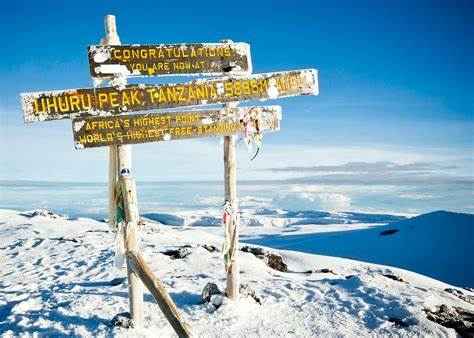7 Day Mt Kilimanjaro Hike via Marangu Route

Overview
The hike on Mount Kilimanjaro via the Marangu Route, often referred to as the "Coca-Cola Route," is one of the most popular and accessible paths to the summit. This route is known for its well-maintained trails and comfortable hut accommodations, making it a preferred choice for many climbers. The trek begins at Marangu Gate, where hikers enter the Kilimanjaro National Park and start their journey through lush rainforest, eventually reaching Uhuru peak. The summit attempt is conducted overnight, with climbers reaching the peak at dawn to witness breathtaking views. The descent is equally rewarding, as hikers return through the rainforest to Marangu Gate, where they receive their summit certificates.This itinerary balances gradual acclimatization with stunning scenery, making it suitable for climbers of varying experience levels. The best times to climb Mount Kilimanjaro are during the dry seasons, which is between January to March and from June to October.
Itinerary
Day 1: Arrival
Your hiking itinerary for Mount Kilimanjaro via the Marangu Route begins with your arrival at Kilimanjaro International Airport, where you will be welcomed by your guide and transferred to your hotel in Moshi for relaxation, preparation and an overnight stay.
Day 2
The next day, after a hearty breakfast, you will depart for the Marangu Gate, the starting point of your trek, where you will complete the necessary registration. The first day’s hike takes you through the lush rainforest, covering approximately 8.3 kilometers (5 miles) to Mandara Hut, located at an altitude of 2,743 meters (9,000 feet). This trek typically takes about 4 to 5 hours, and you will enjoy a picnic lunch along the way. After reaching Mandara Hut, you can relax or take a short walk to the nearby Mahundi Crater for stunning views.
Day 3
After breakfast, you will leave Mandara Hut and head to Horombo Hut, which is situated at 3,720 meters (12,200 feet). This segment of the trek is about 12.5 kilometers (7.8 miles) and usually takes 6 to 8 hours. As you ascend, the scenery changes from rainforest to moorland, offering beautiful views of both Kibo and Mawenzi peaks. You will stop for lunch at Kambi ya Taabu before continuing to Horombo Hut, where you can unwind and enjoy the breathtaking surroundings.
Day 4
This is an acclimatization day at Horombo Hut. This day is crucial for your body to adjust to the altitude. You will embark on a hike towards Mawenzi Hut, passing through Zebra Rocks. This round trip covers approximately 10 kilometers (6.2 miles) and takes about 4 to 5 hours. The hike not only helps with acclimatization but also provides spectacular views of the mountain and its unique landscape. After returning to Horombo Hut, you will have the rest of the day to relax and prepare for the next leg of your journey.
Day 5
On this day, you will have breakfast then trek from Horombo Hut to Kibo Hut, located at 4,703 meters (15,466 feet). This hike is about 10 kilometers (6.2 miles) and typically takes 5 to 6 hours. You will traverse the Saddle, a high-altitude desert between the two peaks, where the landscape is stark and beautiful. Upon reaching Kibo Hut, you will have an early dinner and rest in preparation for the summit attempt.
Day 6
This is the summit day, and you will start your ascent around midnight. The hike from Kibo Hut to Uhuru Peak, the highest point in Africa at 5,895 meters (19,341 feet), covers approximately 6.25 kilometers (3.9 miles) and takes about 5 to 7 hours. The climb is steep and challenging, but the reward of reaching the summit is unparalleled. After taking photos and enjoying the views, you will begin your descent back to Horombo Hut, which will take an additional 5 to 6 hours.
Note: Carry packed food, snacks and water.Wear warmly.
Day 7
On the final day, you will hike from Horombo Hut back to Marangu Gate. This descent covers about 20 kilometers (12.5 miles) and typically takes 6 to 7 hours. The trail takes you through the rainforest once more, allowing you to reflect on your incredible journey. Upon reaching Marangu Gate, you will receive your summit certificate, celebrating your achievement. A vehicle will be waiting to take you back to your hotel in Moshi, where you can enjoy a well-deserved hot shower and celebrate your successful climb.
Equipment needed for the hike.
To successfully hike Mount Kilimanjaro, you will need a comprehensive list of equipment to ensure comfort and safety throughout the trek. Essential items include:
Clothing
Waterproof Jacket: Breathable with a hood.
Insulated Jacket: Synthetic or down for warmth.
Fleece Jacket: For layering.
Hiking Pants: Lightweight and moisture-wicking.
Thermal Base Layers: For added warmth.
Hiking Socks: Wool or synthetic to prevent blisters.
Hat: Brimmed for sun protection and a warm beanie for cold.
Footwear
Hiking Boots: Waterproof and sturdy.
Gaiters: Optional, but useful for muddy or snowy conditions.
Accessories
Trekking Poles: Highly recommended for stability.
Headlamp: With extra batteries for night hikes.
Water Bottles: At least 3-4 liters capacity.
Sunglasses: UV protection is essential.
Sleeping Gear
Sleeping Bag: Rated for cold temperatures.
Sleeping Pad: For comfort (optional).
Personal Items
First Aid Kit: Basic supplies for emergencies.
Toiletries: Including sunscreen and insect repellent.
Snacks: High-energy, lightweight options.
Documentation
Passport and Visa: Required for entry into Tanzania.
Insurance Documents: For safety during the hike.
This gear list ensures you are prepared for the varying weather conditions and altitude changes you will encounter on your Kilimanjaro adventure.
